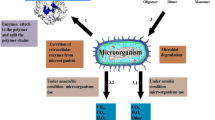Abstract
Oilsands are suspended fine solids in bitumen in which asphaltenes become adsorbed on the surfaces of these particles, reducing the quality of the oil and hence generating higher costs for the oil industry. Since some polymers containing specific functional groups are able to interact with asphaltenes, it can be expected that these kinds of polymers are able to reduce the amount of asphaltene adsorbed. In this work, the performance of three (co)polymers, with different molar ratios of cardanol and styrene was evaluated in the adsorption process of a model system (pentane insoluble asphaltenes—C5I in kaolinite) monitored by ultraviolet–visible spectrometry. Kaolinite and asphaltene were characterized by scanning electron microscopy with energy dispersive X-ray spectroscopy and the wettability of these samples was measured with a goniometer, before and after the adsorption process. The increase in polymer concentration (from 0.025 to 0.2%w/v) reduced the amount of adsorbed asphaltenes on kaolinite. Polycardanol homopolymer presented the best performance, indicating the important role of the hydroxyl group and pendent hydrocarbon chain on the adsorption of asphaltenes on kaolinite. The results evidence the potential of polycardanol, obtained from a renewable source, in the extraction process of bitumen from oil sand.










Similar content being viewed by others
References
Adams JJ (2014) Asphaltene adsorption, a literature review. Energy Fuels. https://doi.org/10.1021/ef500282p
Al-Futaisi A, Jamrah A, Al-Rawas A, Al-Hanai S (2007) Adsorption capacity and mineralogical and physic-chemical characteristics of Shuwaymiyah palygorskite. Environ Geol. https://doi.org/10.1007/s00254-006-0430-y
Andersen S (1994) Concentration effects in HPLC-SEC analysis of petroleum asphaltenes. J Liq Chromatogr. https://doi.org/10.1080/10826079408013600
Bazoubandi B, Soares JBP (2020) Amylopectin-graft-polyacrylamide for the flocculation and dewatering of oil sands tailings. Miner Eng. https://doi.org/10.1016/j.mineng.2020.106196
Botha L, Davey S, Nguyen B, Swarnakar AK, Rivard E, Soares JBP (2017) Flocculation of oil sands tailings by hyperbranched functionalized polyethylenes (HBfPE). Miner Eng. https://doi.org/10.1016/j.mineng.2017.02.004
Brostow W, Lobland HEH (2016) Materials: introduction and applications. Wiley, New Jersey
Caglar B, Çirak C, Tabak A, Afsin B, Eren E (2013) Covalent grafting of pyiridine-2-methanol into kaolinite layers. J Mol Struct. https://doi.org/10.1016/j.molstruc.2012.08.004
Cakié MD, Nikolie GS, Illié LA (2003) Bull Chem Technol Macedonia 21:135–146
Celia-Silva LG, Vilela PB, Morgado P, Lucas EF, Martins LFG, Filipe EJM (2020) Preaggregation of asphaltenes in the presence of natural polymers by molecular dynamics simulation. Energy Fuels. https://doi.org/10.1021/acs.energyfuels.9b03703
Dang-Vu T, Jha R, Wu S-Y, Tannant DD, Masliyah J, Xu Z (2009) Wettability determination of solids isolated from oil sands. Colloids Surf A. https://doi.org/10.1016/j.colsurfa.2008.11.055
Dudášová D, Simon S, Hemmingsen PV, Sjöblom J (2008) Study of asphaltenes adsorption onto different minerals and clays. Part 1. Experimental adsorption with UV depletion detection. Colloids Surf A. https://doi.org/10.1016/j.colsurfa.2007.09.023
Ferreira SR, Louzada HF, Dip RMM, Gonzalez G, Lucas EF (2015) Influence of the architecture of additives on the stabilization of asphaltenes and water-in-oil emulsions separation. Energy Fuels. https://doi.org/10.1021/acs.energyfuels.5b02337
Giles CH, Silva APDD, Trivedi AS (1970) Surface area determination. Butterworth, London, p 135
Gu G, Zhou Z, Xu Z, Masliyah JH (2003) Role of kaolinite clay in toluene-diluted bitumen/water emulsion. Colloids Surf A. https://doi.org/10.1016/S0927-7757(02)00422-3
Gumfekar SP, Soares JBP (2018a) A novel hydrophobically-modified polyelectrolyte for enhanced dewatering of clay suspension. Chemosphere. https://doi.org/10.1016/j.chemosphere.2017.12.009
Gumfekar SP, Soares JBP (2018b) Polymer reaction engineering tools to design multifunctional polymer flocculants. Chemosphere. https://doi.org/10.1016/j.chemosphere.2018.06.175
Honse SO, Ferreira SR, Mansur CRE, González G, Lucas EF (2012) Separation and characterization of asphaltenic subfractions. Quim Nova. https://doi.org/10.1590/S0100-40422012001000019
Institute of Petroleum of London (1995) IP 143: standard methods for analysis and testing of petroleum and related products, London.
Kim YJ (2010) Canada’s oil sands: strategic decisions to make Canada an energy superpower. Thesis of Master of Applied Science in Systems Design Engineering - University of Waterloo, Ontario. https://uwspace.uwaterloo.ca/bitstream/handle/10012/5451/100831_THESIS_Kim%2c%20Young%20Jae_Final.pdf?sequence=1&isAllowed=y
Lopes AAS, Carneiro EA, Rios MAS, Hiluy Filho JJ, Carioca JOB, Barros GG, Mazzetto SE (2008) Study of antioxidant property of a thiosphorated compound derived from cashew nut shell liquid in hydrogenated naphthenics oils. Braz J Chem Eng. https://doi.org/10.1590/S0104-66322008000100013
Loureiro T, Dip RMM, Lucas E, Spinelli L (2018) Cardanol polymerization under acid conditions by addition and condensation reactions. J Poly Environ. https://doi.org/10.1007/s10924-017-0969-6
Lucas EF, Mansur CRE, Spinelli L, Queirós YGC (2009) Polymer science applied to petroleum production. Pure Appl Chem. https://doi.org/10.1351/PAC-CON-08-07-21
Lucas EF, Spinelli LS, Khalil CN (2015) Encyclopedia of polymer science and technology. In: Mark HF (ed) Wiley, New York
Maravilha TSL, Spinelli LS (2018) Polycardanol and poly(cardanol‐co‐styrene): synthesis, characterization, and performance as asphaltene flocculant. Macromol Symp.https://doi.org/10.1002/masy.201800105
Mazzeo CPP, Stedille FA, Mansur CRE, Ramos ACS, Lucas EF (2018) Flocculation of asphaltenes by polymers: influence of polymer solubility conditions. Energy Fuels. https://doi.org/10.1021/acs.energyfuels.7b02577
Mazzetto SE, Oliveira LDM, Lomonaco D, Veloso PA (2012) Braz J Chem Eng 29:519–524
Middea A, Fernandes TLAP, Neumann R, Gomes OFM, Spinelli LS (2013) Evaluation of Fe(III) adsorption onto palygorskite surfaces. Appl Surf Sci. https://doi.org/10.1016/j.apsusc.2013.05.113
Neuhaus N, Nascimento PTH, Moreira I, Scheer AP, Santos AF, Corazza ML (2019) Thermodynamic analysis and modeling of brazilian crude oil and asphaltene systems: an experimental measurement and a pc-saft application. Braz J Chem Eng. https://doi.org/10.1590/0104-6632.20190361s20170575
Neves AM, Santanna VC, Barillas JLM, Dantas TNC, Góis AGB (2020) Ionic surfactants applied in enhanced oil recovery: adsorption, imbibition, and zeta potential approaches. Braz J Chem Eng. https://doi.org/10.1007/s43153-020-00020-2
Nikakahtari H, Vagi L, Choi P, Liu Q, Gray MR (2013) Solvent screening for non-aqueous extractions of Alberta oil sands. Can J Chem Eng. https://doi.org/10.1002/cjce.21751
Osaky M, Geramian M, Liu Q, Ivey DG (2014) Surface properties of petrologic end-members from Alberta oil sands and their relationship with mineralogical and chemical composition. Energy Fuels. https://doi.org/10.1021/ef402150z
Palermo LCM, Lucas EF (2016) Asphaltene aggregation: influence of composition of copolymers based on styrene-stearyl methacrylate and styrene-stearyl cinnamate containing sulfate groups. Energy Fuels. https://doi.org/10.1021/acs.energyfuels.6b00444
Paula RSF, Vieira RS, Luna FMT, Cavalcente CL Jr, Figueiredo IM, Candido JR Jr, Silva LP, Marinho ES, Neto PL, Lomonaco D, Mazzetto SE, Rios MAS (2020) A potential bio-antioxidant for mineral oil from cashew nutshell liquid: an experimental and theoretical approach. Braz J Chem Eng 5:10. https://doi.org/10.1007/s43153-020-00031-z
Reis LG, Oliveira RS, Palhares TN, Spinelli LS, Lucas EF, Vedoy RL, Asare E, Soares JBP (2016) Using acrylamide/propylene oxide copolymers to dewater and densify mature fine tailings. Miner Eng. https://doi.org/10.1016/j.mineng.2016.06.005
Sajini T, Gigimol MG, Mathew B (2019) Kinetic and thermodynamic studies of molecularly imprinted polymers for the selective adsorption and specific enantiomeric recognition of D-mandelic acid. J Polym Res. https://doi.org/10.1007/s10965-019-1746-0
Silva MS, Santana GP (2013) Sci Amazon 2:54–70
Soares JBP, Motta FL (2019) Using polymer reaction engineering principles to help the environment: the case of the Canadian oil sands tailings. J Braz Chem Soc 30(3):426–435
Vajihinejad V, Guilhermo R, Soares JBP (2017) Dewatering oil sands mature fine tailings (MFTs) with poly(acrylamide-co-diallyldimethylammonium chloride): effect of average molecular weight and copolymer composition. Ind Eng Chem Res. https://doi.org/10.1021/acs.iecr.6b04348
Vajihinejad V, Soares JBP (2018) Monitoring polymer flocculation in oil sands tailings: a population balance model approach. Chem Eng J. https://doi.org/10.1016/j.cej.2018.04.039
Wang S (2011) Understanding stability of water in diluted bitumen emulsions by colloidal forces measurements. Thesis of Doctor of Philosophy in Chemical Engineering, Faculty of Graduate Studies and Research—University of Alberta, Edmonton. https://era.library.ualberta.ca/items/61b6f9c2-98f2-46d4-bfc6-ccffee8e4e78. Accessed 27 Sept 2019
Wang S, Liu Q, Tan X, Xu C, Gray MR (2013) Study of asphaltene adsorption on kaolinite by X-ray photoelectron spectroscopy and time-of-flight secondary ion mass spectroscopy. Energy Fuels. https://doi.org/10.1021/ef4001314
Wang C, Harbottle D, Oingxia L, Zhenghe X (2014) Current state of fine mineral tailings treatment: a critical review on theory and practice. Miner Eng. https://doi.org/10.1016/j.mineng.2014.01.018
Younes GR, Proper AR, Rooney TR, Hutchinson RA, Gumfekar SP, Soares JBP (2018) Structure modifications of hydrolytically-degradable polymer flocculant for improved water recovery from mature fine tailings. Ind Eng Chem Res. https://doi.org/10.1021/acs.iecr.8b02783
Zou W, Fang Z, Zhang Z, Lu Z (2019) Interaction and adsorption of hydrophobically modified polyacrylamide on silica and asphaltene surfaces. Adv Polym Technol. https://doi.org/10.1155/2019/5423178
Funding
This study was funded by FAPERJ (Fundação Carlos Chagas Filho de Amparo à Pesquisa do Estado do Rio de Janeiro—E-26/201.233/2014, E-26/202.371/2017 and E-26/202.372/2017), CNPq (Conselho Nacional de Desenvolvimento Científico e Tecnológico—307193/2016-0 and 311551/2019-0) and CAPES (Coordenação de Aperfeiçoamento Pessoal e Nível Superior).
Author information
Authors and Affiliations
Contributions
All authors contributed to the study conception and design. Material preparation, data collection and analysis were performed by TSLM, AM, LSS and EFL. The first draft of the manuscript was written by TSLM and all authors commented on previous versions of the manuscript. All authors read and approved the final manuscript.
Corresponding author
Ethics declarations
Conflict of interest
The authors declare that they have no conflict of interest.
Additional information
Publisher's Note
Springer Nature remains neutral with regard to jurisdictional claims in published maps and institutional affiliations.
Rights and permissions
About this article
Cite this article
Maravilha, T.S.L., Middea, A., Spinelli, L.S. et al. Reduction of asphaltenes adsorbed on kaolinite by polymers based on cardanol. Braz. J. Chem. Eng. 38, 155–163 (2021). https://doi.org/10.1007/s43153-020-00082-2
Received:
Revised:
Accepted:
Published:
Issue Date:
DOI: https://doi.org/10.1007/s43153-020-00082-2




